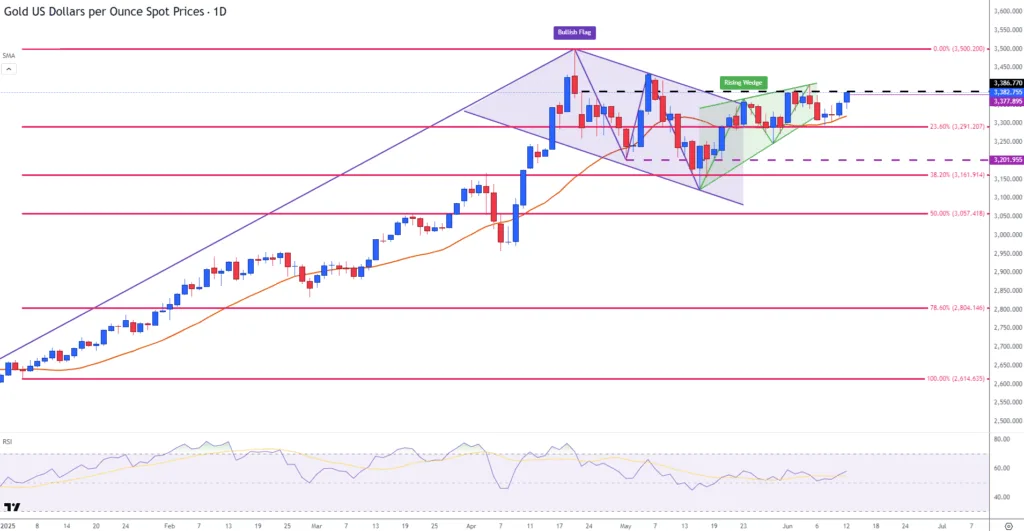
Gold (XAU/USD) is once again in the spotlight due to economic uncertainty and geopolitical concerns. Increasing tensions in the Middle East and Donald Trump’s renewed tariff threats are driving the gold surge. As traders seek safer assets in response to central bank activity and inflation data, gold prices are currently hovering around $3,380. Additionally, a risk-off sentiment is being supported by the escalation between Israel and Iran, as well as weak US inflation.
Gold Surge Fueled by Global Pressure and Policy Moves
Two major factors that have contributed to gold’s strength this week are political risk and the state of the economy. It has unsettled markets because of the possibility of Israeli military action against Iran. NBC News reports that Israel is considering attacking Iran in response to growing threats. Furthermore, Trump fueled the unrest by threatening new tariffs and announcing that the United States would soon establish its trade laws. Due to these developments, investors worldwide are gravitating toward safe-haven assets.
Meanwhile, reports confirm that US military personnel are being relocated from Middle Eastern zones. This is in line with this weekend’s nuclear negotiations between the US and Iran. Since these conversations could determine short-term risk, the market sentiment is still cautious. Therefore, safe-haven demand continues to support the surge in gold prices.
PPI Data and Fed Outlook Support Bullish Trend
Gold’s bullish momentum is also supported by the economic environment. A weak CPI report on Wednesday suggested that US inflation was slowing, which raised expectations of a possible rate cut by the Fed. These patterns are anticipated to be supported by the next Producer Price Index (PPI) report. Analysts predict a 2.6% annual increase in the May PPI. However, the data core PPI might stay constant at 3.1%.
The argument for rate cuts is strengthened by lower US inflation. As a result, the US dollar and bond yields have declined, giving the current gold boom more leeway. Therefore, the likelihood of a September Fed rate cut was 52% before the CPI data. According to the CME FedWatch Tool, this probability increased to 70% after the data.
Central banks are expanding their gold reserves, which contributes to the long-term appeal of gold. According to the ECB’s annual report, holdings were close to Bretton Woods-era highs at 36,000 tonnes. Central banks globally are buying more gold, and that trend supports stability in prices. These factors make gold an appealing asset amid uncertain markets.
Can Gold Rally Sustain Above Key Resistance?
From a technical standpoint, gold remains in an uptrend. The current price is testing a $3,380 resistance zone. However, a breakout above this level could target the $3,400 mark, and potentially April’s high near $3,500. The RSI is pointing upward at 57, indicating further upside. However, $3,350 remains a strong support level. If it falls below this, $3,291 might become more noticeable.

In the future, the direction of the gold boom will be determined by US economic data as well as geopolitical risk. If tensions in the Middle East worsen or new tariff threats surface, gold might reach all-time highs. On the other hand, improvements in inflation data or a reduction in tensions may limit gains. For guidance, traders are paying close attention to the nuclear talks this weekend and the Fed’s communications the following week.
Outlook Remains Bullish Amid Global Uncertainty
The gold price surge is more than just a short-term reaction; it reflects widespread market uncertainty. Investors are responding to signs of a slowdown in US inflation, new tariff threats, and instability in the Middle East. As the Fed is under pressure to lower interest rates and central banks are increasing their gold reserves, the bullish setup is still in place. As a result, the shift away from riskier assets makes gold more appealing during volatile periods. Gold remains a dependable store of value despite the increased volatility in global markets.







